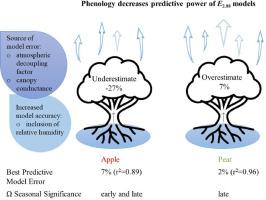Agricultural and Forest Meteorology ( IF 5.6 ) Pub Date : 2022-01-18 , DOI: 10.1016/j.agrformet.2022.108824 Michael A. Forster 1, 2, 3 , Tony D.H. Kim 3 , Sylvie Kunz 3 , Majed Abuseif 3 , Vishal R Chulliparambil 3 , Jannany Srichandra 3 , Ruby N. Michael 3

|
Transpiration is a fundamental biophysical process, directly measured in plants by dividing sap flow by total leaf area. Under non-limiting conditions, transpiration and reference evapotranspiration (ETo) are hypothesized to be equal when ETo is normalized by the leaf area index of the reference crop, i.e., LAI = 2.88. Known as the E2.88 model, it has only been tested with ETo derived from Penman-Monteith FAO56. Phenological influences on canopy conductance potentially decouple transpiration from atmospheric evaporative demand and lower the accuracy of E2.88. This study tested the accuracy of 20 E2.88 models in predicting apple (Malus domestica (Suckow) Borkh. var. Granny Smith) and pear (Pyrus communis L. var. Beurre Bosc Pear) transpiration over the 2020-2021 austral growing season. For apple, the Penman-Monteith ASCE-EWRI model had the highest predictive power with 7% error and r2 = 0.89; whereas for pear the Valiantzas (2018, Eq. (7)) showed 2% error and r2 = 0.96 evaluated via linear regression. Generally, models that included a humidity parameter had stronger predictive power than models excluding humidity. Yet, the predictive power of the E2.88 models decreased considering the phenological phases for each crop. For apple, early and late season E2.88 models underestimated transpiration by at least 27%. For pear, late season error increased to 7% as the E2.88 models overestimated transpiration. Canopy conductance and the atmospheric decoupling factor were significantly greater in early and late season for apple and significantly lower in late season for pear. Therefore, phenology decreased the predictive power of the E2.88 model in early and late season by decoupling physiological processes from atmospheric evaporative demand.
中文翻译:

物候学和冠层电导限制了 20 个蒸散模型预测蒸腾的准确性
蒸腾作用是一个基本的生物物理过程,通过将液流除以总叶面积直接在植物中测量。在非限制性条件下,当ET o通过参考作物的叶面积指数(即LAI = 2.88)归一化时,假设蒸腾量和参考蒸散量( ET o)相等。被称为E 2.88模型,它仅使用源自 Penman-Monteith FAO56的ET o进行了测试。物候对冠层电导的影响可能使蒸腾与大气蒸发需求脱钩,并降低E 2.88的准确性。本研究测试了 20 E 2.88的准确度预测苹果(Malus domestica (Suckow) Borkh. var. Granny Smith)和梨(Pyrus Communis L. var. Beurre Bosc Pear)在 2020-2021 年南方生长季节蒸腾的模型。对于苹果,Penman-Monteith ASCE-EWRI 模型的预测能力最高,误差为 7%,r 2 = 0.89;而对于梨,Valiantzas (2018, Eq. (7)) 显示出 2% 的误差,并且 通过线性回归评估r 2 = 0.96。一般来说,包含湿度参数的模型比不包含湿度的模型具有更强的预测能力。然而,考虑到每种作物的物候阶段, E 2.88模型的预测能力下降。对于苹果,早晚季节E2.88 个模型低估了蒸腾作用至少 27%。对于梨,由于E 2.88模型高估了蒸腾作用,晚季误差增加到 7% 。苹果的冠层电导率和大气解耦因子在早季和晚季显着增大,而在梨的晚季显着降低。因此,物候学通过将生理过程与大气蒸发需求脱钩,降低了E 2.88模型在早晚季节的预测能力。











































 京公网安备 11010802027423号
京公网安备 11010802027423号